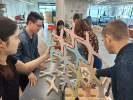News and views for the UB community
Research News
UB teams with Alfred University to advance stackable ceramic façade prototype

Architecture Dean Robert G. Shibley (far left) meets with Team UB-Alfred in UB's SMART Fabrication Factory to review progress of their ceramic facade prototype. The research was presented at the sixth annual Architectural Ceramic Assemblies Workshop on Aug. 19. Photo: Jin Young Song
By RACHEL TEAMAN
Published August 20, 2021
A team of UB architecture faculty and students has developed a stackable ceramic facade system that opens new possibilities in user-generated architecture and sculptural geometries in terra cotta.
The research, being pursued with a team of faculty and students from Alfred University’s College of Ceramics, was presented at the 2021 Architectural Ceramic Assemblies Workshop (ACAW), which took place virtually on Aug. 19. UB was both a participant and co-organizer of the sixth annual ACAW event, along with Boston Valley Terra Cotta and the Carnegie Mellon School of Architecture.
The facade prototype developed by UB employs a system of uniform terra cotta units that are stacked and locked into place using fastening techniques derived from traditional wood joinery. The system pairs Alfred University’s design and material expertise in ceramics with UB’s capacity in digital fabrication and façade-system design using terra cotta.
The UB team is led by Jin Young Song, associate professor of architecture, whose research interests focus on the tension between structure and ornament in architecture, and Dan Vrana, fabrication manager for the School of Architecture and Planning, along with a team of graduate architecture students. Jongmin Shim, associate professor of civil and structural engineering, has provided research guidance on the structural integrity of the facade system.
Much of the research has unfolded over the past year in UB’s Sustainable Manufacturing and Advanced Robotic Technologies (SMART) Fabrication Factory in Parker Hall on the South Campus. The terra cotta units were cut and shaped using the facility’s industry-grade, five-axis, waterjet cutter. A system of 3D-printed dowels, also designed and fabricated by the UB team, allow the pieces to “lock” into place. The Alfred team has supported research on the design and glazing of the terra cotta tiles, which are formed using a mold and then cut with the waterjet before being fired and glazed.
Reconfigurable system explores impermanence
The reconfigurability of the interlocking, modular wall system creates the potential for user interaction with the architecture. For example, a screen wall can be stacked high in the summer for shading and then lowered in the winter to allow for more light. The natural heat-retaining abilities of terra cotta also support passive heating and cooling.
“The project celebrates the permanence of terra cotta as a material while exploring the impermanence of the built environment,” says Song. “Users can build and unbuild meaningful structural supports using the modular system.”
Vrana, who has guided fabrication research for the project, says the system also aims to achieve geometric freedom based on limited block types and 3D-printed dowels that allow for continuously changing contact surfaces.
Using curvilinear X-shaped tiles, the top and bottom parts provide an identical surface-to-surface load transfer for structural integrity while leaving the geometry of the side opening free from the stacking mechanism. This allows for a customized porosity of the wall construction and minimizes the waterjet-cutting process for the interlocking mechanism.
On top of the porosity control, this stacking behavior works with a wide range of thicknesses, which can provide a more refined structural solution.
The ACAW brings together professionals from the architectural industry and academia, offering participants the opportunity to explore terra cotta in high-performance, large-scale assemblies. Through pre-design and prototype research and development, teams explore new digital tools in the production of terra cotta assemblies, development of unitized façade systems, and how the variable materiality of terra cotta can inform and enhance a façade’s performance.
Research and experimentation at past workshops have culminated in real-world projects currently in development. UB, which was instrumental in launching ACAW in 2016 based on its more than a decade-long research collaboration with Boston Valley Terra Cotta, has developed several exploratory terra cotta facade systems through the workshop, including Terra-Cotta Grotto in 2019.
In addition to Team UB-Alfred, teams participating in this year’s ACAW workshop included Tod Williams Billie Tsien and Walter P. Moore and Associates Inc.; COOKFOX Architects and Buro Happold; HOK, TriPyramid and Permasteelisa North America & Josef Gartner; Goody Clancy and Simpson Gumpertz & Heger (SGH); Architecture Research Office (ARO) and Heintges TriPyramid; Studio Gang and Walter P. Moore and Associates Inc; and Carnegie Mellon University. Teams will present their studies and constructed system models to an audience of facade designers, engineers and ceramicists.







